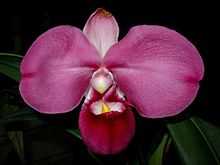Phragmipedium kovachii
| Phragmipedium kovachii | |
|---|---|
 | |
| Scientific classification | |
| Kingdom: | Plantae |
| (unranked): | Angiosperms |
| (unranked): | Monocots |
| Order: | Asparagales |
| Family: | Orchidaceae |
| Subfamily: | Cypripedioideae |
| Genus: | Phragmipedium |
| Species: | P. kovachii |
| Binomial name | |
| Phragmipedium kovachii Atwood, Dalström & Fernandez | |
| Synonyms | |
|
Phragmipedium peruvianum Christenson | |
Phragmipedium kovachii (heterotypic synonym Phragmipedium peruvianum) is an orchid species discovered in 2001 in the Amazon jungle of NE Peru, which is considered to be the most important orchid species to be found in the Neotropics in the last 100 years.[1]
Phragmipedium kovachii is a terrestrial orchid, growing in tufts. Its flowers are 11–15 cm wide and dark pink to royal purple.
This orchid has been categorized in the section Schluckebieria of the genus Phragmipedium .[2]
Discovery
In May 2002, James Michael Kovach, of Virginia, traveled to Peru with his friend Lee Moore, a man who has traded orchids.[3] On May 26, 2002, he arrived in El Progresso, a town in San Martín region of Peru. Then a person offered an orchid from the Peruvian jungle, a big colorful Phragmipedium orchid. He bought 3 pots. That night Moore told him, "This is your chance. You've got the Holy Grail of orchids."
Kovach arrived in Miami on June 4, 2002, with 300 orchids and at least one new unclassified Phragmipedium. He took it to Marie Selby Botanical Gardens in Sarasota. J.T. Atwood, S. Dalstron and Fernandez published its description in Selbyana magazine on June 12, 2002. Kovach suggested that the orchid be named Phragmipedium kovachii.
A few days after the Selbyana publication, a description of the species as Phragmipedium peruvianum by Eric Christenson, an expert of the American Orchid Society, was published in the Orchids magazine (June 17, 2002) claiming that the suggested name was a prohibited name. The name peruvianum has been considered not to be a good choice for some experts because a similar name has been used before (Phragmipedium peruviana), but was not validly published, for a species which was later named Phragmipedium richteri.
On June 20, 2002, the Peruvian Government asked the U.S. Fish and Wildlife Service to investigate Marie Selby Botanical Gardens. All species of Phragmipedium are protected under the Convention on International Trade in Endangered Species (CITES) of Wild Fauna and Flora.[4]
On June, 10th, 2004[5] the U.S. District Court in Tampa, Florida, declared that Kovach was guilty of violating the endangered species act.[6] Kovach received two years' probation and a $1,000 fine for transporting the endangered flower from Peru to the United States.[3]
A nomenclatural proposal was put forward in 2006 to declare the name Phragmipedium kovachii invalid and to add its original ad hoc publication "Selbyana vol. 23 Supplement" to the “opera utique oppressa” (ICN Appendix VI).[7] Counterarguments were presented in several articles.[8] The Nomenclature Committee for Vascular Plants declined to accept the proposal, stating "if all names based on specimens illegally collected or named after persons who have acted unwisely ... were to be rejected, we might have some major nomenclatural instability."[8] The International Botanical Congress of 2011 subsequently accepted the committee's recommendation.
CITES-legitimate plants, both young and adult size, are now increasingly available commercially, due to the Peruvian government licensing two nurseries to enable this.
Growing conditions

In its natural habitat in Peru, Phragmipedium kovachii receives alkaline water, as the plants grow on decomposed limestone. This is in stark contrast to all other known species of Phragmipedium, which consistently expect somewhat acidic water.
Their roots are constantly kept moist by water trickling and flowing over them. This water is nearly always at about 55 degrees F.
One interesting aspect of this species is the fact that the bloom continues to grow after opening. About 10 mm of additional width of the flower can be expected each day in the first several days after opening.
Notes
- ↑ John Beckner (Marie Selby Botanical Gardens): This is the most spectacular, the most sensational, the most incredible looking orchid in 100 years or more
- ↑ G.J. Braem (2004). "Phragmipedium kovachii, Schluckebieria – nouvelle section du genre Phragmipedium et réflexions sur les pratiques taxinomiques". Richardiana 4 (3): 89102.
- ↑ 3.0 3.1 "Michael Kovach received two years' probation and a $1,000 fine for transporting the endangered flower from Peru to the United States". St. Petersburg Times. November 2, 2004. Retrieved 2007-12-02.
- ↑ The Department of Justice indicted Kovach for importing a protected Peruvian orchid on Wednesday, November 19, 2003. Washington DC.
- ↑ Department of Justice. Virginia orchid dealer pleaded guilty to violating the endangered species act. Thursday, June 10, 2004. Washington DC.
- ↑ Craig Pittman: The Case of the Purloined Orchid. How one little flower wreaked heartache and havoc over Selby Gardens
- ↑ Van Rijckevorsel, Paul. "Proposal to add Selbyana vol. 23 Supplement to the "opera utique oppressa"". Taxon 55 (4): 1053–1053. doi:10.2307/25065718.
- ↑ 8.0 8.1 Brummitt, R.K. (2009). "Report of the Nomenclature Committee for Vascular Plants: 60". Taxon 58 (1): 280–292.
References
- Christenson, Eric. "Phragmipedium peruvianum, The Most Glorious New Phragmipedium Species in Two Decades is Described", 2002, Orchids 71, no. 7 620-22
- Selbyana 23 Supplement: 1 with the official publication
- Damian, M. L., Williams, N. H., and Whitten, W. M. 2005. Phragmipedium kovachii: molecular systematics of a New World orchid. Orchids 74(2): 132-137.
- Description in Orchidmania
- PJ Cribb (2005). "Plant portraits: 511. Phragmipedium kovachii. Orchidaceae". Curtis's Botanical Magazine 22 (1): 8–11. doi:10.1111/j.1355-4905.2005.00454.x.
External links
| Wikimedia Commons has media related to Phragmipedium kovachii. |
| Wikispecies has information related to: Phragmipedium kovachii |